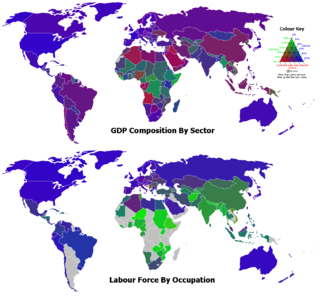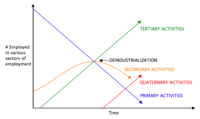Industry
2008/9 Schools Wikipedia Selection. Related subjects: Business

An industry or sector (from Latin industrius, "diligent, industrious") is the manufacturing of a good or service within a category.
There are four key sectors of industry: the primary sector, largely raw material extraction industries such as mining and farming; the secondary sector, involving refining and manufacturing; the tertiary sector, which deals with services (such as law and medicine) and distribution of manufactured goods; and the quaternary sector, a relatively new type of industry focusing on technological research, design and development such as computer programming and biochemistry.
In economics and urban planning, industry is a synonym for the secondary sector, which is a type of economic activity involved in the manufacturing of raw materials into goods and products.
Industry in the second sense became a key sector of production in European and North American countries during the Industrial Revolution, which upset previous mercantile and feudal economies through many successive rapid advances in technology, such as the steel and coal production. It is aided by technological advances, and has continued to develop into new types and sectors to this day. Industrial countries then assumed a capitalist economic policy. Railroads and steam-powered ships began speedily establishing links with previously unreachable world markets, enabling private companies to develop to then-unheard of size and wealth. Following the Industrial Revolution, perhaps a third of the world's economic output is derived from manufacturing industries—more than agriculture's share.
Many developed countries (for example the UK, the U.S., and Canada) and many developing/semi-developed countries (People's Republic of China, India etc.) depend significantly on industry. Industries, the countries they reside in, and the economies of those countries are interlinked in a complex web of interdependence.
History
Proto-industry
Early industries involved manufacturing goods for trade, including weapons, clothing, pottery. In medieval Europe, industry became dominated by the guilds in cities and towns, who mutual support for the member's interests, and maintained standards of workmanship and ethical conduct.
Industrial development
The industrial revolution led to the development of factories for large-scale production, with consequent changes in society. Originally the factories were steam-powered, but later transitioned to electricity once an electrical grid was developed. The mechanized assembly line was introduced to assemble parts in a repeatable fashion, with individual workers performing specific steps during the process. This led to significant increases in efficiency, lowering the cost of the end process. Later automation was increasingly used to replace human operators. This process has accelerated with the development of the computer and the robot.
Declining industries
Historically certain manufacturing industries have gone into a decline due to various economic factors, including the development of replacement technology or the loss of competitive advantage. An example of the former is the decline in carriage manufacturing when the automobile was mass-produced.
A recent trend has been the migration of prosperous, industrialized nations toward a post-industrial society. This is manifested by an increase in the service sector at the expense of manufacturing, and the development of an information-based economy, the so-called informational revolution. In a post-industrial society, manufacturing is relocated to more economically-favorable locations through a process of offshoring.
Industrial technology
There are several branches of technology and engineering specialised for industrial application. This includes mathematical models, patented inventions and craft skills. See automation, industrial architecture, industrial design, industrial process, industrial arts and industrial applicability.
Industry and the environment
- See pollution and industrial ecology.
Industry sectors and classification
There are many other different kinds of industries, and they are usually divided into different classes or sectors. The primary sector of industry is agriculture, mining and raw material extraction. The secondary sector of industry is manufacturing - which is what is colloquially meant by the word "industry". The tertiary sector of industry is service production. Sometimes one talks about a quaternary sector of industry, consisting of intellectual services such as R&D.
- light industry - heavy industry
- labor-intensive industry - capital-intensive industry
- By product: chemical industry, petroleum industry, meatpacking industry, hospitality industry, food industry, fish industry, software industry, paper industry, entertainment industry, semiconductor industry, cultural industry, poverty industry
ISIC
ISIC(rev.4) stands for International Standard Industrial Classification of ALL economic activities, the most complete and systematic industrial classification made by United Nations Statistics Division. ISIC Rev.4 is a standard classification of economic activities arranged so that entities can be classified according to the activity they carry out. The categories of ISIC at the most detailed level (classes) are delineated according to what is, in most countries, the customary combination of activities described in statistical units and considers the relative importance of the activities included in these classes. While ISIC Rev.4 continues to use criteria such as input, output and use of the products produced, more emphasis has been given to the character of the production process in defining and delineating ISIC classes.
Yahoo!Finance
Industry Centre by Yahoo!Finance is also very useful (shows Trends of all industrial sectors).
